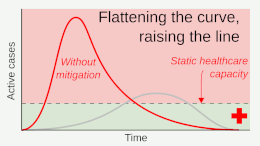A pandemic is an epidemic of an infectious disease that has spread across a large region, for instance multiple continents or worldwide, affecting a substantial number of people. (An epidemic is the rapid spread of disease to a large number of people in a given population within a short period of time.)
A widespread endemic disease (an infection within a population that is constantly maintained at a baseline level in a geographical area without external inputs) with a stable number of infected people is not a pandemic. Widespread endemic diseases with a stable number of infected people such as recurrences of seasonal influenza are generally excluded as they occur simultaneously in large regions of the globe rather than being spread worldwide.
A disease of condition is not a pandemic merely because it is widespread and kills many people; it must also be infectious. For instance, cancer is responsible for many deaths but is not considered a pandemic because the disease is neither infectious nor contagious.

Management
The basic strategies in the control of an outbreak are containment and mitigation. Containment may be undertaken in the early stages of the outbreak, including contact tracing and isolating infected individuals to stop the disease from spreading to the rest of the population, other public health interventions on infection control, and therapeutic countermeasures such as vaccinations which may be effective if available. When it becomes apparent that it is no longer possible to contain the spread of the disease, management will then move on to the mitigation stage, in which measures are taken to slow the spread of the disease and mitigate its effects on society and the healthcare system. In reality, containment and mitigation measures may be undertaken simultaneously.



A key part of managing an infectious disease outbreak is trying to decrease the epidemic peak, known as “flattening the epidemic curve”. This helps decrease the risk of health services being overwhelmed, and provides more time for a vaccine and treatment to be developed. A broad group of the so-called non-pharmaceutical interventions may be taken to manage the outbreak. In a flu pandemic, these actions may include: personal preventive measures such as hand hygiene, wearing face-masks, and self-quarantine; community measures aimed at social distancing such as closing schools and cancelling mass gatherings; community engagement to encourage acceptance and participation in such interventions; and environmental measures such as cleaning of surfaces.

Useful Links
Centers for Disease Control and Prevention
